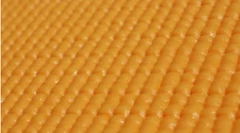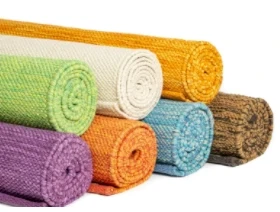Have you thought about the materials in your yoga mat? Choosing a high quality yoga mat for the type of yoga you practice can be helpful for your health and the environment. Making the wrong choice could have a negative effect on your practice as well as Mother Earth.
An important relationship for the yogi is the connection to the earth. At its origins, in India, yoga was practiced in a room with a clay floor on a traditional mat made of raw silk or a natural cotton cloth. Using these materials helps the body connect directly to the earth.
This pure, steady connection to the earth is important as it helps the yogi experience the practice in the traditional way.
“The yogi’s seat, in a clean place, should be firm (not wobbly), neither too high nor too low and covered first, with kusha grass, then with deer or tiger skin, then with a cloth.” – The Bhagavad Gita
In the ancient Indian scripture that inspired the origins of yoga, The Bhagavad Gita states the importance of using natural materials during the practice of yoga.
The use of natural materials is still important. Think of your foundation and what it is built upon. The stronger and more grounded your connection to the earth, the better experience you have in your practice.
There are tons of yoga mats options available for the yoga enthusiast and it can feel overwhelming to understand the differences between them. Whether you practice yoga at home or at a studio, picking the right yoga mat is important. Use this guide to learn how to find the right eco-friendly yoga mat that will be beneficial for your practice.
1. Plastic (Sticky Mats)
The plastic (sticky mats) we often see as the staple in yoga classes are polyvinyl chloride (PVC) mats. They have a texture and stickiness that often yogis feel are an important part of the practice.
However, they are made from petroleum and are known to be toxic to one’s health and the environment. Its advantages are as a building material — it is cheap, easy to install and replace. For this reason, it is often used as a substitute for wood, concrete and clay in many areas.
For the yogi who is seeking to have improved physical and spiritual health – PVC yoga mats should be avoided.

2. PER (Polymer Environmental Resin)
PER is offered as an eco-friendly alternative to PVC. It’s sometimes referred to as PVC that can biodegrade. However, biodegradable plastics that can break down into extremely small particles, are still plastic.
PER starts as PVC, which has been plasticized and stabilized with chemicals (ATBC) instead of phthalates and lead. It is not “PVC-free”. Some yogis object to the chemical/plastic smell of mats made with PER.
Overall, mats made of this material are not valued for its eco-friendliness.
3. TPE (Thermoplastic Elastomers)
TPE mats are a mix of polymers that include a combination of rubber and plastic or something else entirely. There are seven main TPE groups available commercially. One of the most common and least expensive are Styrenic Block Copolymers (SBCS).
What are SBCS?
Styrene and butadiene are potentially carcinogenic materials.
Most mat manufacturers don’t reveal what is in the TPE in their yoga mats.
Even if a yoga mat is promoted as not made of PVC, unless they reveal what is the mixture of TPE in the yoga mat material — we can’t be certain that it is safe and without negative health or environmental impact.
4. Rubber
Many “sustainable” rubber mats are “made with natural rubber that contain no PVC or other synthetic rubbers.” These mats are often described as having a combination of natural and man-made components. Some manufacturers state their rubber yoga mats contain no heavy metals, ozone-depleting substances, PVC, TPE, phthalates and formaldehyde.
But, there’s a catch. These mats may contain nitrosamines.
On the energetic level, a yogi might not like how rubber acts as an insulator and has the potential to block energy flow during asana practice.
5. Cork
Cork yoga mats are considered sustainable and are a good replacement for plastic mats. They are generally non-slip, have hydrophobic qualities and are antimicrobial (slowing the spread of fungi). They are environmentally friendly and biodegradable.
However, yogis who practice a long time have complained that they can show fold-lines and often don’t stay rolled up; they may be difficult to use as a travel mat or to practice outdoor yoga.
6. Cotton
A cotton yoga mat provides a traditional and classic foundation for yoga. It’s a natural material, hypoallergenic and keeps the body cool. Organic cotton can be grown using 90% less water than conventional cotton. It provides more grip with sweat.
Most important…this natural material allows for energy to flow and a more direct connection to the earth. A cotton yoga mat works indoors and outdoors (rain or shine). They can be folded for outdoor yoga practices.

The Afterlife of a Yoga Mat
Most yoga mats are biodegradable. The main difference is that some last for a few years while others last hundreds of years in a landfill.
The best alternative to upcycling, recycling or repurposing a yoga mat is to simply have it ‘retire’ in a home as an area rug or hallway runner. That way there is no need to wait for its next incarnation while decomposing in a landfill!
Yoga means unity, to unite oneself with your true essence. Choose a yoga mat that helps you energetically, physically and has minimal impact on our environment.
Read Next: The True Value Of An Eco-Friendly Yoga Mat





